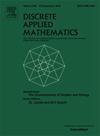Upper bounds and approximation results for the k-slow burning problem
IF 1
3区 数学
Q3 MATHEMATICS, APPLIED
引用次数: 0
Abstract
-slow burning is a model for contagion in social networks. In this model, given an undirected graph in every time step, first every burning vertex spreads the fire to up to of its neighbours, before second one additional source of fire is ignited. The -slow burning number, denoted by , is the minimum number of time steps needed until the whole graph is burning. This model can be seen as a combination of the classic graph burning problem and the much older (-)broadcasting problem. We prove -hardness of the -slow burning problem for every fixed on path forests, spider graphs and most notably the class of graphs of radius 1, where normal graph burning is solvable in polynomial time. Furthermore, we show that among all connected graphs on vertices, the -slow burning number of the star graph, , is maximal for and asymptotically maximal for fixed . This observation motivates a generalisation of the burning number conjecture for -slow burning. Finally, we give a -approximation for the -slow burning problem on path forests and a 2-approximation on trees.
求助全文
约1分钟内获得全文
求助全文
来源期刊

Discrete Applied Mathematics
数学-应用数学
CiteScore
2.30
自引率
9.10%
发文量
422
审稿时长
4.5 months
期刊介绍:
The aim of Discrete Applied Mathematics is to bring together research papers in different areas of algorithmic and applicable discrete mathematics as well as applications of combinatorial mathematics to informatics and various areas of science and technology. Contributions presented to the journal can be research papers, short notes, surveys, and possibly research problems. The "Communications" section will be devoted to the fastest possible publication of recent research results that are checked and recommended for publication by a member of the Editorial Board. The journal will also publish a limited number of book announcements as well as proceedings of conferences. These proceedings will be fully refereed and adhere to the normal standards of the journal.
Potential authors are advised to view the journal and the open calls-for-papers of special issues before submitting their manuscripts. Only high-quality, original work that is within the scope of the journal or the targeted special issue will be considered.
 求助内容:
求助内容: 应助结果提醒方式:
应助结果提醒方式:


